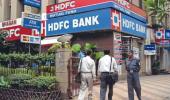Highly-rated finance firms and housing finance companies are expected to benefit from the absence of Housing Development Finance Corp (HDFC) from the bond market once it merges with the HDFC Bank in early FY24.

Post merger, the bond market is expected to become less crowded, which will ease fund raising conditions for other players in the field.
It may perhaps also compress the spread for debt instruments floated by housing finance companies (HFCs) over 10-year government bonds, subject to demand and supply conditions.
Debt market analysts said the largest home finance company HDFCs annual market fund raising has been around Rs 50,000 crore.
Post-merger the requirement for HDFC Bank could be halved as it may continue to raise money via bonds for affordable housing.
This by current estimates would open up space for others could be Rs 25,000-30,000 crore.
The likely beneficiaries of HDFC’s exit are highly-rated instruments (carrying AAA ratings) HFCs like LIC Housing, Bajaj Housing Finance and NBFCs from Tata and Aditya Birla stable, senior executives with merchant banking firms said.
On March 17, HDFC informed stock exchanges that the Mumbai bench of National Company Law Tribunal has approved the merger of mortgage financier HDFC into HDFC Bank.
The merger already has approvals from regulators including Reserve Bank of India (RBI) and the two stock exchanges.
The merger was announced in April 2022. HDFC Bank is still awaiting clarity from the RBI on the forbearances it has sought.
According to rating agency ICRA, overall loan book of non-banking financial companies in the retail segment and housing finance companies would reach about Rs 30 trillion by March 2024 compared to Rs 23 trillion in March 2022.
Fresh funding of Rs 2.9-3.3 trillion in FY24 would be required for achieving the estimated growth, the agency said.
While HDFC vacates space, new infrastructure lender National Bank for Financing Infrastructure and Development (NabFID) will also be in the market to raise funds.
The government of India has infused Rs 20,000 crore in NabFID as equity.
The financial institution would leverage an equity base for raising money through bonds for lending operations.
Ajay Manglunia, managing director and head of fixed income, JM Financial group said the infrastructure investments are in robust mode.
So besides NabFID, there are many public sector players who will be active in the market for raising resources.
The volume of fundraising has been in low gear in the recent weeks due to uptick in yield levels.
At present, bank funding is available at competitive rates as compared to long-term non-convertible debentures (NCDs).
Tightened systemic liquidity, elevated inflation levels and the slower deposit growth rate vis-à-vis credit growth would push-up bank rates at a faster pace than the trend witnessed so far.
Retail-NBFCs continue to maintain higher on-balance sheet liquidity compared to the pre-pandemic level. HFCs’ liquidity has moderated somewhat but remains higher than the 2018 level, ICRA said.











